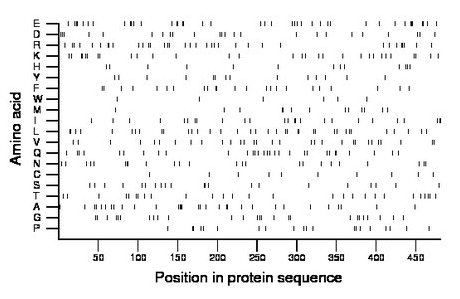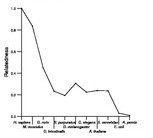
| Name: PUS3 | Sequence: fasta or formatted (481aa) | NCBI GI: 199559785 | |
|
Description: pseudouridylate synthase 3
|
Referenced in:
| ||
|
Composition:

Amino acid Percentage Count Longest homopolymer A alanine 6.4 31 3 C cysteine 2.1 10 1 D aspartate 5.0 24 1 E glutamate 8.7 42 3 F phenylalanine 4.8 23 2 G glycine 5.4 26 1 H histidine 2.7 13 1 I isoleucine 5.2 25 2 K lysine 6.2 30 2 L leucine 7.5 36 2 M methionine 2.9 14 2 N asparagine 5.0 24 2 P proline 4.2 20 2 Q glutamine 6.2 30 2 R arginine 7.3 35 2 S serine 4.4 21 1 T threonine 5.6 27 1 V valine 6.2 30 1 W tryptophan 1.2 6 1 Y tyrosine 2.9 14 1 |
Comparative genomics:
Search single species RefSeq proteins at NCBI
Search summary 
Figure data | ||
Related human proteins:Protein Relative score Description Self-match 1.000 pseudouridylate synthase 3 PUS1 0.055 pseudouridine synthase 1 isoform 2 PUS1 0.055 pseudouridine synthase 1 isoform 2 PUS1 0.055 pseudouridine synthase 1 isoform 1 PUSL1 0.041 pseudouridylate synthase-like 1 LETM1 0.007 leucine zipper-EF-hand containing transmembrane prote... TMF1 0.007 TATA element modulatory factor 1 COL6A6 0.007 collagen type VI alpha 6 ETV6 0.006 ets variant 6 CGNL1 0.006 cingulin-like 1 CCDC149 0.006 coiled-coil domain containing 149 isoform 2 CCDC149 0.006 coiled-coil domain containing 149 isoform 1 DNAH17 0.006 PREDICTED: dynein, axonemal, heavy chain 17 DNAH17 0.006 PREDICTED: dynein, axonemal, heavy chain 17 DNAH17 0.006 PREDICTED: dynein, axonemal, heavy chain 17 VAPB 0.006 VAMP-associated protein B/C GCC1 0.005 Golgi coiled-coil protein 1 PDIK1L 0.005 PDLIM1 interacting kinase 1 like MAP7 0.005 microtubule-associated protein 7 SCLT1 0.005 sodium channel associated protein 1 EP300 0.004 E1A binding protein p300Human BLASTP results (used to prepare the table) | |||
Gene descriptions are from NCBI RefSeq. Search results were obtained with NCBI BLAST and RefSeq entries. When identical proteins are present, the self-match may not be listed first in BLASTP output. In such cases, the table above has been reordered to place it first.
See About the Figures for the scoring system used in the figure above right. The same scoring system was used in the table of BLASTP results.
Guide to the Human Genome
Copyright © 2010 by Stewart Scherer. All rights reserved.
